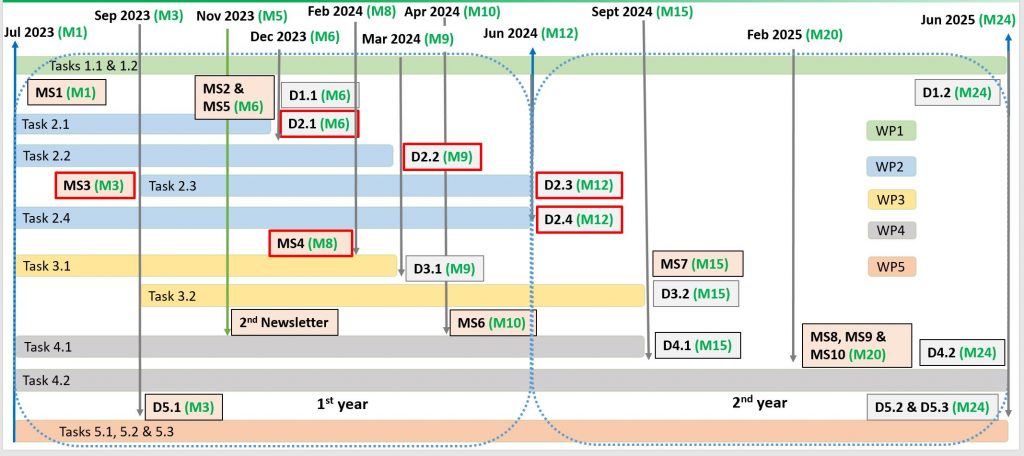Summary
WP2 (yellow colour in Fig.1) will help describe and understand the current state of the mining heritage in Europe. It aims at determining the transition strategy from coal mining in each of the countries (Greece, Germany, France, Poland, and Slovenia) for each partner involved in the project, indicating actions taken, processes undergone until now and present status of coal transition. In this work package the project partners will determine the processes needed to declare coal sites as national heritage areas with emphasis on legislative considerations of the coal sites (owners and the legal process of the facilities transfer) and estimation of the national heritage value to explore its potential (social value and SWOT analysis). The outcome of the work package will be the development of questionnaires as part of a stakeholder analysis.
Each of the partner countries in the project has an extensive coal history. Times of coal prosperity when the mining infrastructure and facilities were significantly developed are over and the current economic, environmental, and social situation forces governments to withdraw from the coal industry.

Objectives
The main aim of this WP is to describe the current state of the industrial (coal) mining heritage in Europe in relation to legislation, policy, land use and ownership. This will be achieved through:
- Preparation of studies regarding the coal mining transition strategy,
- Identification of the processes to declare a coal mining site as a national heritage,
- Development of questionnaires to identify the awareness level of the stakeholders on industrial heritage (knowledge on the history of coal mining, perception and interest in, cultural heritage, acceptance of preservation measures, financial support measures etc).
Activities and division of work
WP 2 is separated in 4 distinctive Tasks, 2.1, 2.2, 2.3 and 2.4 (with blue colour in Fig. 2) which will have as outcome 4 Deliverables, D2.1, D2.2, D2.3 and D2.4 (red colour in Fig. 2). This WP is also linked with 2 Milestones MS3, & MS4 (red colour in Fig. 2).

Task 2.1 Identification of the transition strategy in each collaborate country and its status – transformation process analysis
Within this task, each partner (CERTH, KOMAG, GIG, BRGM, PV and DMT-THGA) will prepare a study of their country’s transition strategy from coal mining. They will indicate actions taken and processes undergone until now. The partners will also present the status of coal transition in their countries. The document will contain information on plans to close and liquidate the mines, a description of possible ways to retrain the staff working in the mining industry and in mining-related plants in such a way as to minimize the social impacts of coal mines closure.
Task 2.2 Identification of the processes needed to declare the coal sites as national heritage areas
This task will focus on the concept of cultural & and industrial heritage trying to define it. The term of geoheritage referring to coal itself (outcrops, palaeontological and mineralogical collections) will also be included. It will require the partners to gather information and present the processes needed to identify the coal sites as national heritage areas in their countries. The elements developed under this task will be: legislation, policy, land use and land ownership with the emphasis on:
- legislative considerations of the coal sites (owners and the legal process of the facilities transfer)
- estimation of the national heritage value to explore its potential (social value and SWOT analysis). To achieve this, potential geoheritage inventories that take place in many European countries will be taken into consideration in order to retrieve data.
Task 2.3 Experiences and insights from European countries that already declared mining regions as cultural/ industrial heritage
Under this task, selected European countries will be presented as for their best practices in declaring coal regions cultural or industrial heritage. A case study will be prepared for the chosen regions (Poland, Ruhr area/Germany, France, and others); comparative analysis will be conducted (the TRACER project and others similar could provide valuable information). The political, social and legal conditions for the transformation of coal mining will be included (linking and contributing to the activities of Task 2.2).
Task 2.4 Public perception of industrial heritage in coal regions
Industrial heritage sites are of technical-historical, artistic, architectural, scientific, cultural and social relevance and are therefore maintained. They are the base for identities, scientific knowledge and relevant for economic change. The decision process for or against the preservation of a certain object, the process of conservation and the permanent monitoring brings together people, technical innovation and identities. Societal change and the purpose of questioning the youth and younger adults are important for identity.
